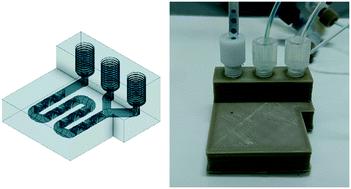当前位置:
X-MOL 学术
›
React. Chem. Eng.
›
论文详情
Our official English website, www.x-mol.net, welcomes your
feedback! (Note: you will need to create a separate account there.)
3D printing of PEEK reactors for flow chemistry and continuous chemical processing
Reaction Chemistry & Engineering ( IF 3.4 ) Pub Date : 2020-03-23 , DOI: 10.1039/c9re00408d Matthew J. Harding 1, 2, 3, 4, 5 , Sarah Brady 2, 3, 4, 5, 6 , Heather O'Connor 2, 3, 4, 5, 6 , Rafael Lopez-Rodriguez 1, 2, 3, 4, 7 , Matthew D. Edwards 1, 2, 3, 4, 7 , Saoirse Tracy 2, 3, 4, 8 , Denis Dowling 2, 3, 4, 5, 6 , Geoff Gibson 4, 9, 10 , Kevin P. Girard 11, 12, 13 , Steven Ferguson 1, 2, 3, 4, 5
Reaction Chemistry & Engineering ( IF 3.4 ) Pub Date : 2020-03-23 , DOI: 10.1039/c9re00408d Matthew J. Harding 1, 2, 3, 4, 5 , Sarah Brady 2, 3, 4, 5, 6 , Heather O'Connor 2, 3, 4, 5, 6 , Rafael Lopez-Rodriguez 1, 2, 3, 4, 7 , Matthew D. Edwards 1, 2, 3, 4, 7 , Saoirse Tracy 2, 3, 4, 8 , Denis Dowling 2, 3, 4, 5, 6 , Geoff Gibson 4, 9, 10 , Kevin P. Girard 11, 12, 13 , Steven Ferguson 1, 2, 3, 4, 5
Affiliation

|
Chemically resistant parts for flow chemistry, with integrated mixing elements have been produced using the 3D printing process of fused filament fabrication, from poly(etheretherketone). Poly(etheretherketone) has greater chemical resistance than common fused filament fabrication materials such as acrylonitrile butadiene styrene, polypropylene, or even high-performance plastics like poly(etherimide), in addition to having superior thermal resistance and excellent mechanical strength. Printed reactors were demonstrated to be suitable for liquid–liquid extraction and flow chemistry and to be capable of withstanding pressures of at least 30 bar allowing superheated solvents to be used. Burst tests in simple geometries of 20 minute duration have indicated that increased operating pressures of up to 60 bar could be accommodated in future reactor designs. The ability to use fused filament fabrication for these reactors allows highly customisable, cost effective flow reactors and equipment to be fabricated on relatively inexpensive benchtop scale printers. X-ray microcomputed tomography was utilised to non-invasively image and verify the internal structure of the prints to ensure fidelity in reactor fabrication. This non-invasive method of equipment validation shows potential in helping to demonstrate regulatory compliance for bespoke additively manufactured components, for example in continuous pharmaceutical manufacturing where the methods and printer used in this work should be sufficient to produce, (continuous) manufacturing scale equipment.
中文翻译:

用于流动化学和连续化学处理的PEEK反应器的3D打印
具有流动性的耐化学腐蚀部件,带有集成的混合元件,是通过聚醚醚酮的3D打印工艺制造的熔丝制造的。聚(醚醚酮)比普通的熔融长丝制造材料(如丙烯腈丁二烯苯乙烯,聚丙烯或什至高性能塑料(如聚醚酰亚胺))具有更高的耐化学性,此外还具有出色的耐热性和出色的机械强度。印制反应器被证明适用于液-液萃取和流动化学,并且能够承受至少30 bar的压力,从而可以使用过热的溶剂。在20分钟持续时间的简单几何形状中进行的爆破测试表明,未来的反应堆设计可适应高达60 bar的增加的工作压力。将熔融长丝制造用于这些反应器的能力允许在相对便宜的台式规模的打印机上制造高度可定制的,具有成本效益的流动反应器和设备。X射线计算机断层扫描技术被用于非侵入性成像和验证印刷品的内部结构,以确保反应堆制造的保真度。这种非侵入式的设备验证方法具有潜力,可以帮助证明定制的增材制造组件的法规遵从性,例如在连续制药中,该工作中使用的方法和打印机应足以生产,
更新日期:2020-04-24
中文翻译:

用于流动化学和连续化学处理的PEEK反应器的3D打印
具有流动性的耐化学腐蚀部件,带有集成的混合元件,是通过聚醚醚酮的3D打印工艺制造的熔丝制造的。聚(醚醚酮)比普通的熔融长丝制造材料(如丙烯腈丁二烯苯乙烯,聚丙烯或什至高性能塑料(如聚醚酰亚胺))具有更高的耐化学性,此外还具有出色的耐热性和出色的机械强度。印制反应器被证明适用于液-液萃取和流动化学,并且能够承受至少30 bar的压力,从而可以使用过热的溶剂。在20分钟持续时间的简单几何形状中进行的爆破测试表明,未来的反应堆设计可适应高达60 bar的增加的工作压力。将熔融长丝制造用于这些反应器的能力允许在相对便宜的台式规模的打印机上制造高度可定制的,具有成本效益的流动反应器和设备。X射线计算机断层扫描技术被用于非侵入性成像和验证印刷品的内部结构,以确保反应堆制造的保真度。这种非侵入式的设备验证方法具有潜力,可以帮助证明定制的增材制造组件的法规遵从性,例如在连续制药中,该工作中使用的方法和打印机应足以生产,











































 京公网安备 11010802027423号
京公网安备 11010802027423号